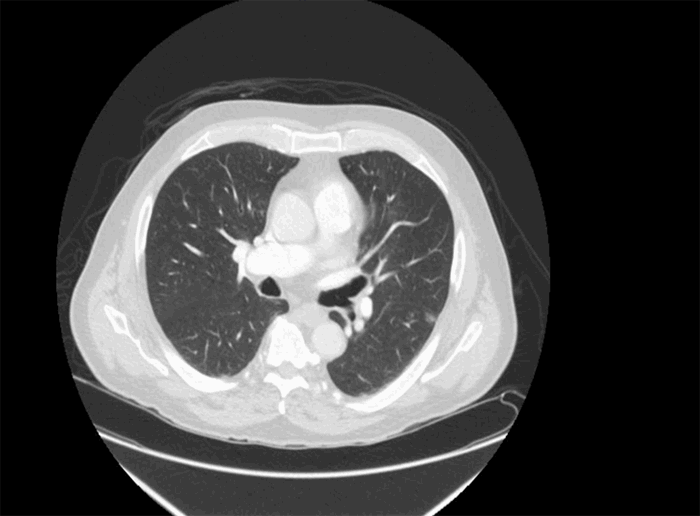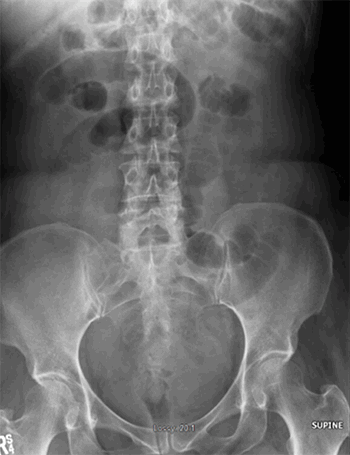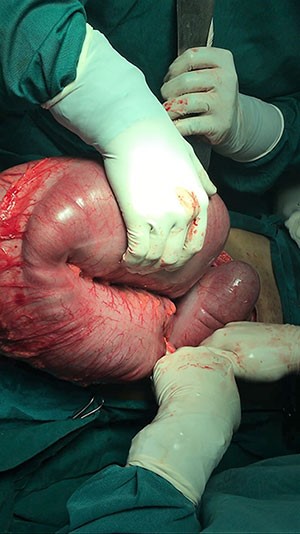Table 1. Arterial blood gas (ABG) and lactate measurement by hospital day. VV-ECMO therapy was initiated at approximately 13:00 hours on hospital day one. The patient underwent excision of bilateral full thickness arm burn at approximately 13:00 hours on hospital day three.
The patient's respiratory acidosis remained refractory to ventilator manipulation, including assist control ventilation with a tidal volume (Tv) of 500 ml (8ml/kg adjusted for ideal body weight [IBW]) and a rate of 30 respirations/min as well as a trial of pressure control ventilation. We pursued several adjunct therapies: administration of the renally excreted buffer tris-hydroxymethyl aminomethane (THAM) in order to decrease the ventilation requirement to compensate for the patient’s acidosis; nebulized heparin, albuterol, and n-acetylcysteine to facilitate mucolysis, bronchodilation, and to inhibit fibrin clot formation within the airways; and a single dose of vecuronium (after which we assessed clinically for improved ventilation without twitch monitoring). Of note, oxygenation remained stable on 85-100 percent FiO2 and a positive end expiratory pressure (PEEP) of 10 cm H2O.
Approaching 24 hours postinjury, the patient's ventilatory status worsened and the decision was made to pursue an aggressive alternative strategy with VV ECMO given the patient’s young age and lack of other immediate life threatening injury. An inflow tract for the ECMO circuit was established with a 25 french multi-stage venous catheter inserted through the right femoral vein into the inferior vena cava at the levels of the diaphragm. A second venous catheter (17 French) was placed in the superior vena cava at the level of right atrium under ultrasound guidance via the right internal jugular vein to serve as an outflow tract. We then initiated VV ECMO with a Cardiohelp™ ECMO console and an HLS Bioline Advanced 5.0 circuit at an initial flow rate of 2.6 L/min (LPM) and a sweep gas of 6 LPM. The patient's respiratory acidosis resolved approximately one hour after initiation of ECMO therapy (Table 1). At this time, the patient was placed on lung protective ventilator settings (Vt 300 cc [5 cc/kg IBW], PEEP 10 cm H2O, FiO2 80%). Throughout the duration of ECMO therapy, sweep gas rates were adjusted to maintain a normal pCO2 (35-45 mmHg) as measured by arterial blood gas (ABG). The patient was anti-coagulated on a heparin infusion per institutional policy.
The following 24 hours were notable for anuric acute renal failure with hyperkalemia requiring continuous renal replacement therapy and the development of a profound metabolic (lactic) acidosis. Multiple possible etiologies for her worsening acidosis were considered and treated: sodium thiosulfate for recurrent cyanide toxicity (hydroxocobalamin was administered on scene); an unremarkable exploratory bedside laparotomy; cefepime and vancomycin administration for sepsis; and a left upper extremity and hand escharotomy for increasing compartment pressure. The patient's metabolic acidosis continued to worsen despite our interventions, and by the end of her second hospital day, the patient required vasopressor support with norepinephrine, dobutamine, and vasopressin. Resuscitative fluid was changed to fresh frozen plasma (FFP) and sodium bicarbonate.
To facilitate increased demand for CO2 removal, blood flow through the ECMO circuit was increased to 3.9 LPM and sweep gas increased to 10 LPM. She tolerated continued down-titration of FiO2.
By hospital day three, the patient’s profound lactic acidosis was thought to be a result of burn sepsis and bilateral upper extremity full-thickness burns were excised. During the following 24 hours, she was weaned from vasopressors and stabilized clinically. Interestingly, in the 24 hours prior to excision of the bilateral upper extremity burns, we noted a mixed venous oxygen saturation (SvO2) of 79 percent (Hgb 7.2). Following burn excision there was a persistent drop in SvO2 to 51 percent for approximately 24 hours, despite pRBC transfusion to a Hgb of 8.8. The patient had normal cardiac function during this time as assessed by transthoracic echocardiography.
Further hospital course was significant for excision and grafting of full thickness back burns on hospital day seven which was complicated by significant blood loss (EBL 1.5 L) and continued hemorrhage in the ICU. This required activation of our institution’s massive transfusion protocol (MTP) and administration of 33 units of packed red blood cells, 32 units of FFP, and eight units of platelets. The patient’s heparin infusion had been discontinued intraoperatively once she developed significant hemorrhage. During the MTP, the patient remained on the ECMO circuit and it was challenging to maintain adequate preload in the setting of hemorrhagic shock.
The following day (hospital day eight) the patient stabilized. She was removed from the ECMO circuit and placed on a standard mechanical ventilatory mode. The patient thereafter continued to clinically improve and was weaned from hemodialysis and mechanical ventilation. After several additional operations to excise and graft her burns, the patient was discharged from the hospital 66 days after admission.
Discussion
Recent case series and a meta-analysis have reported limited but encouraging results on the use of ECMO for inhalational burn injury associated with hypoxemic respiratory failure.4,5 Both VV and veno-arterial ECMO have been successfully applied in adult and pediatric burn patients with acute respiratory failure.5,6 However, even the landmark CESAR trial, which revealed a survival benefit from ECMO therapy in medical patients, enrolled relatively few participants with uncompensated hypercapnia.3
Our case is unique in that it presents the application of VV ECMO to correct hypercarbic respiratory failure after a severe inhalational injury. This represents a poorly studied indication for ECMO therapy in burn patients. The ECMO circuit facilitated placing the patient on a lung protective ventilation strategy that, along with aggressive pulmonary hygiene, resulted in a return of pulmonary function within seven days. Although we present evidence limited to a single case, further development and trials of ECMO for profound acute hypercarbic respiratory failure with or without hypoxia may show it to be a valuable bridge therapy in burn patients.
We believe this case also illustrates the phenomenon of cytopathic hypoxia7 in the setting of burn sepsis. The patient experienced a worsening lactic acidosis and vasopressor requirement in the setting of a normal SvO2. Following burn excision, there was a substantial drop in the SvO2 despite correction of the patient’s anemia, improving lactic acidosis, normal cardiac function, and decreasing vasopressor requirement. We hypothesize this may have been due to the return of mitochondrial function and normal aerobic metabolism.
Conclusion
Extracorporeal membrane oxygenation has evidence supporting its use in hypoxemic respiratory failure; however, most published experience has been in medical and burn patients with hypoxemia as the indication for therapy. This case illustrates that VV ECMO may be a valuable bridge therapy in the treatment of acute hypercarbic respiratory failure resulting from inhalational burn injuries.
Lessons Learned
Severe inhalational burn injuries are reversible if pulmonary function can be supported. VV ECMO may be a valuable therapy in the treatment of both hypoxemic and hypercarbic respiratory failure following inhalational burn injuries.
Authors
Spanier MJa, Jara CBb, Carter DWc, Groom RCb, Rappold JFc
Correspondence Author
Matthew Spanier, MD
Department of Emergency Medicine
22 Bramhall Street
Portland, ME, 04102
207-662-7050
mspanier@mmc.org
Author Affiliations
- Maine Medical Center, Department of Emergency Medicine, Portland, ME
- Maine Medical Center, Department of Cardiovascular Perfusion, Portland, ME
- Maine Medical Center, Department of Surgery, Portland, ME
References
- Asmussen S, Maybauer D, Fraser J, et al. Extracorpeal membrane oxygenation in burn and smoke inhalation injury. Burns. 2013;39:429-435.
- Gattinoni L, Pesenti A, Mascheroni D, et al. Low-frequency positive-pressure ventilation with extracorporeal CO2 removal in severe acute respiratory failure. JAMA. 1986;256:881-886.
- Peek G, Mugford M, Tiruvoipati R, et al. Efficacy and economic assessment of conventional ventilatory support versus extracorporeal membrane oxygenation for severe adult respiratory failure (CESAR): a multicentre randomised controlled trial. Lancet. 2009;374:1351-1363.
- Walker P, Buehner M, Wood L, et al. Diagnosis and management of inhalation injury: an updated review. Crit Care. 2015;19:351.
- Hsu P, Tsai Y, Lin C, et al. Benefit of extracorporeal membrane oxygenation in major burns after stun grenade explosion: Experience from a single military medical center. Burns. 2017;43:674-680.
- Askegard-Giesmann J, Besner G, Fabia R, et al. Extracorporeal membrane oxygenation as a lifesaving modality in the treatment of pediatric patients with burns and respiratory failure. J Pediatr Surg. 2010;45:1330-1335.
- Loiacono LA, Shaprio DS. Detection of Hypoxia at the Cellular Level. Crit Care Clin. 2010;26:409-421.






